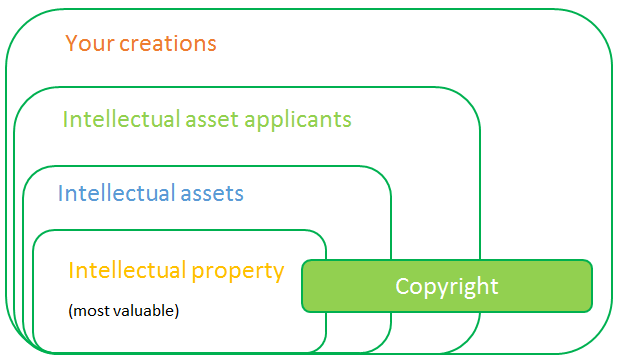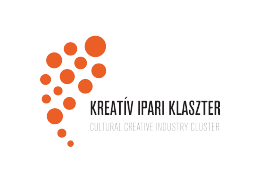Anything printed, written or recorded in any format is subject to copyright law from the moment of its creation. Copyright law exists to give legal protection to creators and publishers of works which include: books (fiction and non-fiction), films, sound recordings, newspaper and journal articles, dramatic works, photographs, and computer programmes, amongst others.
Important!
Copyright cannot be separated from the author, but the economic or licence rights could be assigned to someone else! The Copyright appears to have temporal restrictions.
Consider the following example:
An artist creates a picture, which is exhibited in a hotel....
What kinds of revenue opportunities could the artist have?
• The artist’s contact information is also displayed so anyone can buy it directly from him/her.
• The hotel can sell it directly (in this case a time/space limit may be imposed: i.e. the picture can be sold by the hotel only within a year or the picture could be sold only in the country).
• Both the hotel and the artist may sell it (it is a non-exclusive right for both parties).
• The hotel can sell it, but the artist can use copy of the picture in other forms (i.e. on a T-shirt, or on mug – the merchandising rights remain at the artist).
• The hotel has the merchandising rights as well, i.e. using as a branded design on other products.
These are different examples of different copyright and related rights such as: the right to produce copies, to import or export the work, to create derivative works, to perform/display the work publicly, to sell or cede these rights to others and to transmit or display by radio or video.
Obtaining protection for your work is very easy in countries where the Berne Convention standards apply, because you do not have to apply for official registration, there are however certain legal advantages of doing so (especially in the U.S). This means that if your creation meets the minimum requirements of being original and unique it is qualified for copyright.
Eligible works are...
Poems
Theses
Fictional character plays
Literary works
Pictures
Choreography
Musical compositions
Sound recordings
Paintings
Drawings
Sculptures
Photographs
Computer software
Radio and television broadcasts
Industrial designs
It is important to note that only the form or manner the idea was expressed is protected, not the idea itself: for example, the copyright to Tom & Jerry means that others can’t make copies and derivative works based on this particular cartoon movie, but it does not prohibit others from making cartoons about mice and cats fighting each other as long as they are different enough to be disambiguate from Tom & Jerry.
Your idea itself is not eligible for copyright, you must express it in a specific manner.
Figure 1. How copyright relates to the levels of intellectual assets.

As you can see on Figure 1, the original works you produce fall under the category of copyright without you even thinking about using it in your business. If you do want to use that work in your business it is entitled to the same copyright nevertheless.
The structure of copyright
The different utilization of copyright products are:
• copy and reproduction,
• import and export,
• derivative works,
• performance and display,
• selling and ceding the rights to others,
• transmitting by radio or video.
These can be sold separately: you do not have to sell the right to copy your work if somebody want to place your picture on mugs for example, because that is only a derivative of the original and not a copy.
Copyright also have time-bound limits, meaning it expires usually 50-70 years after the death of the creator if the original work. The time after it expires may vary by country.
The following case will shed light on how difficult is to understand copyright issues and why you should pay attention to copyright when signing a contract or working with somebody.
Consider the example of a logo.
It is a copyrighted work. If your employee creates the logo, you have all the Related Rights (in case you have a proper employment contract with your emit is a job for hire), but if an independent contractor does it for you, the copyright parts are owned by them unless the contract assigns that to you.
Different type of IPs often overlap with each other. Always choose what suits your needs.
How could you protect that?
To use it as a trademark you must register it by the corresponding national authority. If you wish to use that trademark in different countries, you should seek trademark protection in each country, or file an application for a group of countries, such as the EU, the Madrid Protocol or the Andean Pact.
However, if somebody else uses that logo in a country where you did not register your logo as a trademark, you will still be able to sue them for copyright infringement of the original graphic, but cannot sue them for the damages they caused for your company for the use of the trademark.
You should bear in mind that the copyright holder bears the costs of enforcing it, in case of somebody using your work you do not have to take legal action but instead first approach the infringing party and try to settle the dispute out of court.
These rights can be sold to third parties as well and it is important to note the duration of the copyright because it does not last forever, there are different time limits and after that, these work will be in the public domain.
You can also use Creative Common licenses which is a non-profit organisation and helps you to share some or (almost) all of these exclusive rights with the public.
There are several types of licenses you can choose from ranging from the most restrictive one where you can only share the work but no one can change, remix or sell it to the less restrictive where others only have to credit you as author but could even sell it. ( https://creativecommons.org/).












